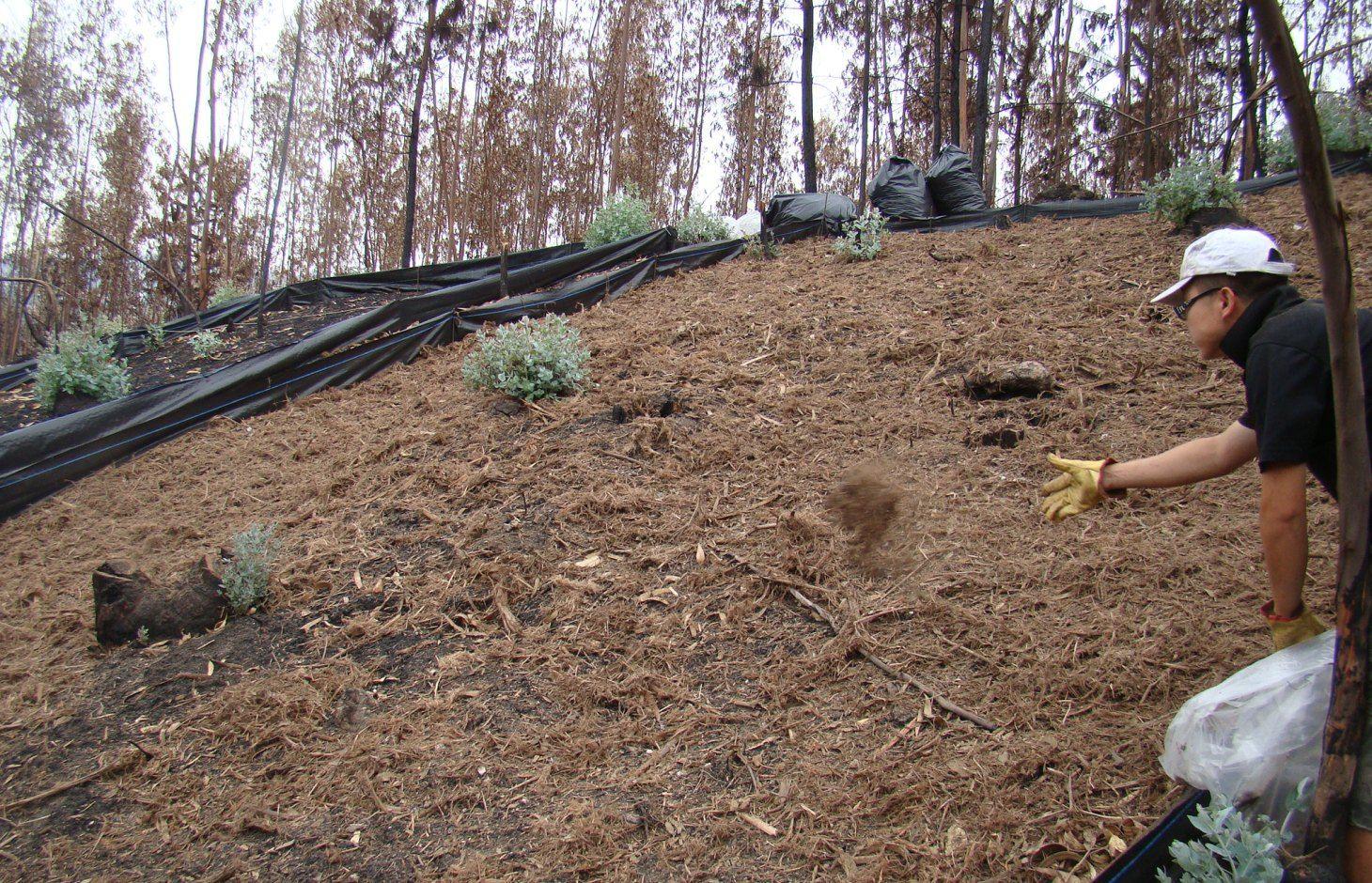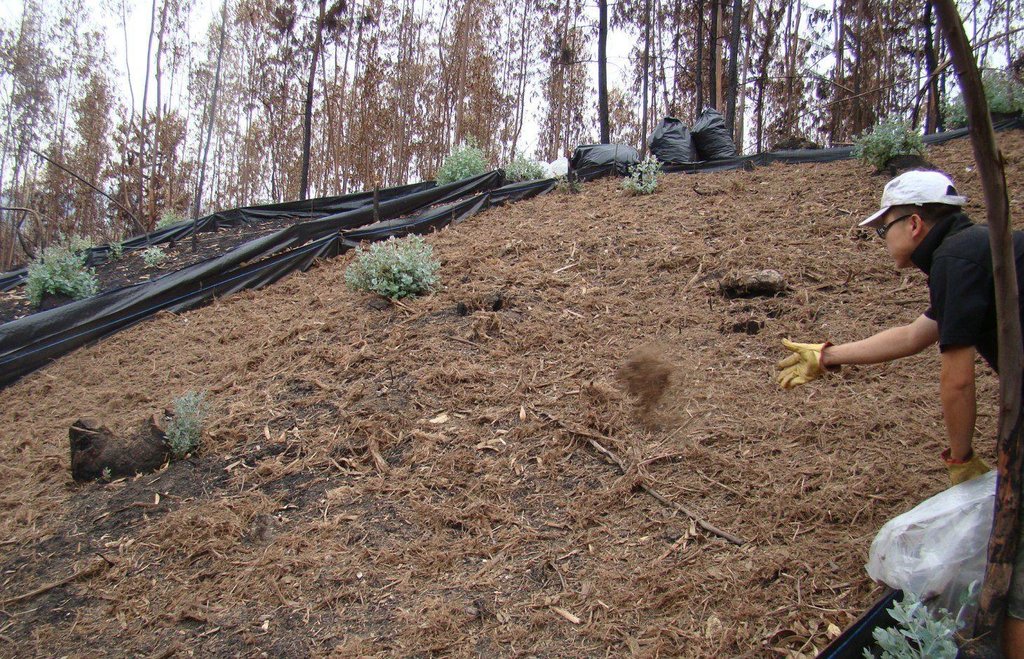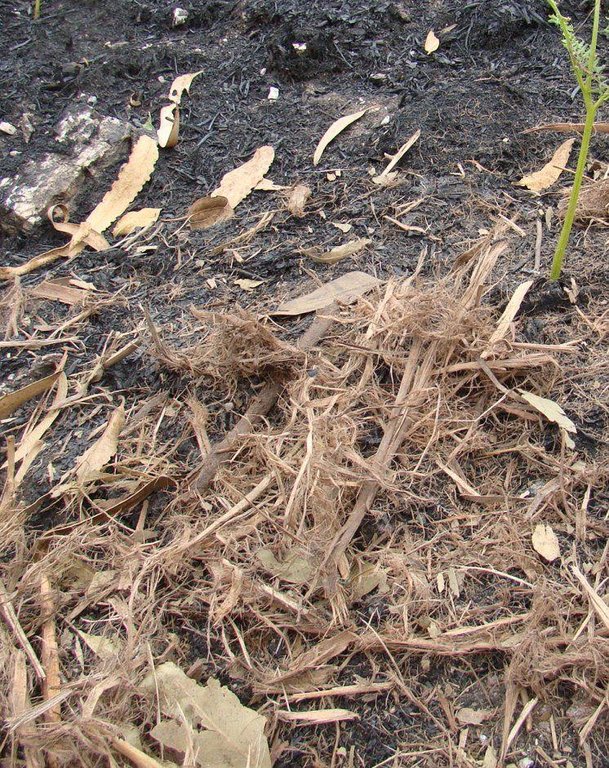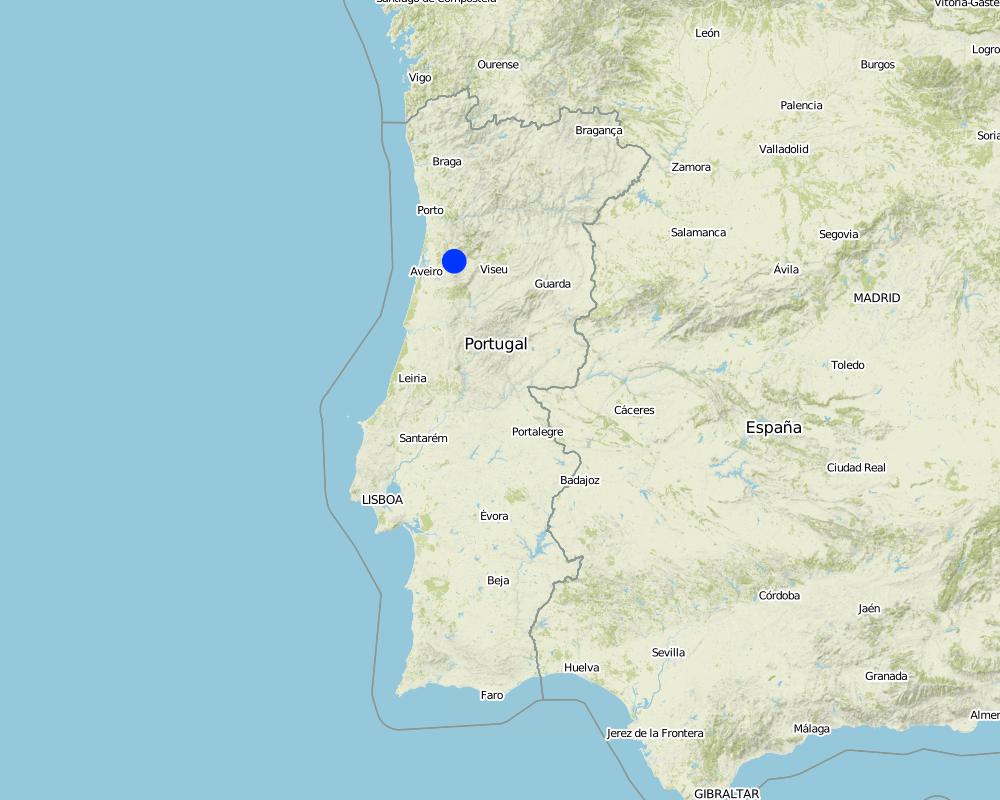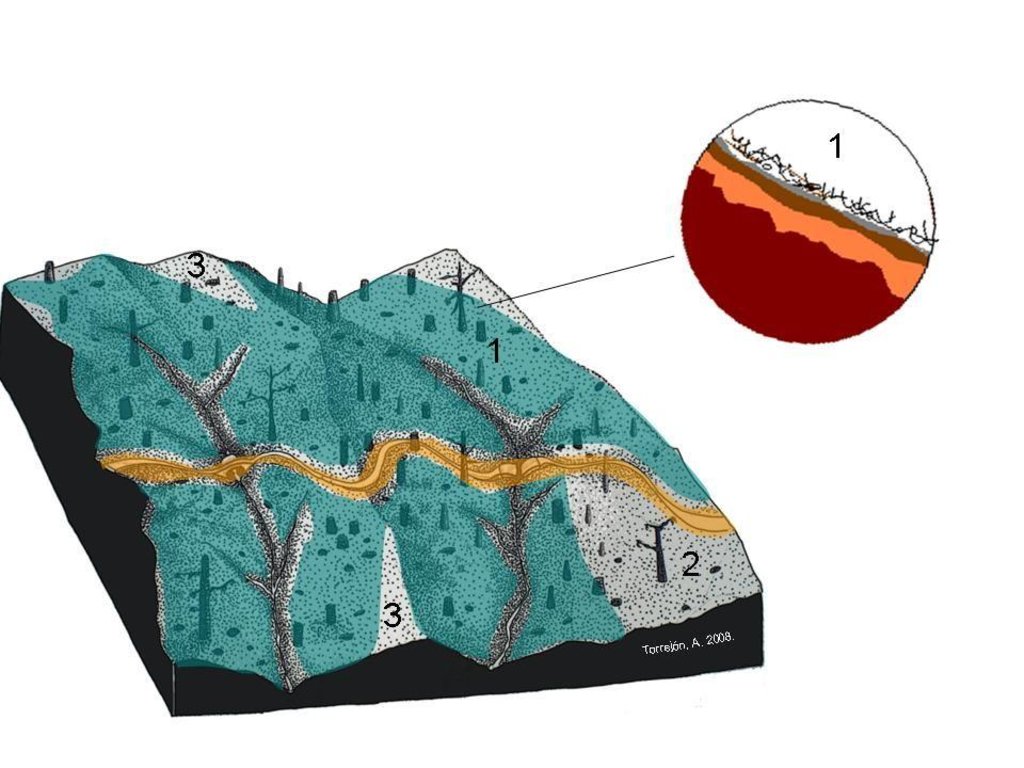Post-fire Forest Residue Mulch [Portugal]
- Création :
- Mise à jour :
- Compilateur : Sergio Prats Alegre Prats
- Rédacteur : –
- Examinateurs : Fabian Ottiger, Alexandra Gavilano
acolchoado, aplicação de restos vegetais
technologies_1186 - Portugal
Voir les sections
Développer tout Réduire tout1. Informations générales
1.2 Coordonnées des personnes-ressources et des institutions impliquées dans l'évaluation et la documentation de la Technologie
Spécialiste GDT:
Keizer Jan Jacob
Universidade de Aveiro-CESAM
Portugal
Spécialiste GDT:
Nom du projet qui a facilité la documentation/ l'évaluation de la Technologie (si pertinent)
Preventing and Remediating degradation of soils in Europe through Land Care (EU-RECARE )Nom du projet qui a facilité la documentation/ l'évaluation de la Technologie (si pertinent)
Catastrophic shifts in drylands (EU-CASCADE)Nom du ou des institutions qui ont facilité la documentation/ l'évaluation de la Technologie (si pertinent)
University of Aveiro (University of Aveiro) - Portugal1.3 Conditions relatives à l'utilisation par WOCAT des données documentées
Le compilateur et la(les) personne(s) ressource(s) acceptent les conditions relatives à l'utilisation par WOCAT des données documentées:
Oui
2. Description de la Technologie de GDT
2.1 Courte description de la Technologie
Définition de la Technologie:
Forest residue mulch is spread immediately after a wildfire in order to prevent soil erosion and reduce overland flow.
2.2 Description détaillée de la Technologie
Description:
In two areas of eucalypt plantations affected by wildfires in central Portugal in 2007 and 2010, the research team of the University of Aveiro set up two experiments in order to test the effect of forest residue mulching as a soil erosion mitigation technique. Forest residues such as chopped eucalypt bark mulch was spread over a group of erosion plots, and was compared to an untreated group of plots.
The mulching was applied at ratios of 8.7 and 10.8 Mg ha-1 provided an initial ground cover of 70 to 80%, and was found to reduce post-fire runoff by 40-50% and soil erosion by 85-90%, respectively.
Purpose of the Technology: The increase in ground cover will decrease post-fire soil erosion by reducing raindrop impact over the ashes and bare soil, and decrease the runoff amount by increasing water surface storage, decreasing runoff velocity, and increase infiltration.
Ideally, post-fire mulching must be carried out immediately after the fire, in order to prevent that the first autumn rainfall events fall over the bare and unprotected burnt soils. It is intended for places in which burnt severity was moderate to high and where there are important values at risk, such as water reservoirs, populations, industries, human and wild life.
Establishment / maintenance activities and inputs: The chopped bark mulch was obtained at a depot 20 km from the burnt area, where eucalypt logs are debarked and then transported to a paper pulp factory. The bark is chopped into fibers and are typically transported to a biomass energy plant. We used these 10–15 cm wide 2–5 cm long bark fibers as the source for our mulching experiment. The chopped bark mulch decays very slowly (around 20% less ground cover per year) which was very useful in cases of low re-growth of natural vegetation.
Natural / human environment: The eucalypt trees in the region are typically planted as monocultures for paper pulp production, and harvested every 7-14 years. The landscape reflects a long history of intense land management, with a mosaic of (semi-)natural and man-made agricultural and afforested lands. Since the 1980´s, however, wildfires have increased dramatically in frequency and extent, aided by a general warming and drying trend but driven primarily by socio-economic changes.
2.3 Photos de la Technologie
2.5 Pays/ région/ lieux où la Technologie a été appliquée et qui sont couverts par cette évaluation
Pays:
Portugal
Région/ Etat/ Province:
Portugal/Beira Litoral
Autres spécifications du lieu:
Sever do vouga/ Pessegueiro do Vouga, Ermida
Spécifiez la diffusion de la Technologie:
- répartie uniformément sur une zone
S'il n'existe pas d'informations exactes sur la superficie, indiquez les limites approximatives de la zone couverte:
- < 0,1 km2 (10 ha)
Commentaires:
Total area covered by the SLM Technology is 1.0E-5 m2.
The experiment was carried out in grous of small bounded plots of 0.25, 16 and 100 m2.
Map
×2.6 Date de mise en œuvre de la Technologie
Si l'année précise est inconnue, indiquez la date approximative: :
- il y a moins de 10 ans (récemment)
2.7 Introduction de la Technologie
Spécifiez comment la Technologie a été introduite: :
- au cours d'expérimentations / de recherches
Commentaires (type de projet, etc.) :
The first experiment was carried out in 2007.
3. Classification de la Technologie de GDT
3.2 Type(s) actuel(s) d'utilisation des terres, là où la Technologie est appliquée

Forêts/ bois
- Plantations d'arbres, boisements
Type d’arbres:
- Espèces d'Eucalyptus
Produits et services:
- Bois d'œuvre (de construction)
- Bois de chauffage
Commentaires:
Major land use problems (compiler’s opinion): Increased runoff and soil erosion, resulting in a decrease of on-site fertility and derived off-site effects such as loss of water quality, reservoirs water volume storage, higher risk of flooding and human beings damage.
Major land use problems (land users’ perception): Loss of wood resources and productivity.
Plantation forestry: eucalypt are logged and left to regrow from stumps each 7-10 years
Forest products and services: timber, fuelwood
Number of growing seasons per year: 1
3.5 Groupe de GDT auquel appartient la Technologie
- Amélioration de la couverture végétale/ du sol
3.6 Mesures de GDT constituant la Technologie

pratiques agronomiques
- A1: Couverture végétale/ du sol
Commentaires:
Main measures: agronomic measures
Type of agronomic measures: mulching
3.7 Principaux types de dégradation des terres traités par la Technologie

érosion hydrique des sols
- Wt: perte de la couche superficielle des sols (couche arable)/ érosion de surface
- Wo: effets hors-site de la dégradation

dégradation chimique des sols
- Cn: baisse de la fertilité des sols et réduction du niveau de matière organique (non causée par l’érosion)

dégradation hydrique
- Hs: changement de la quantité d’eau de surface
- Hp: baisse de la qualité des eaux de surface
Commentaires:
Main type of degradation addressed: Wt: loss of topsoil / surface erosion, Hs: change in quantity of surface water, Hp: decline of surface water quality
Secondary types of degradation addressed: Wo: offsite degradation effects, Cn: fertility decline and reduced organic matter content
Main causes of degradation: crop management (annual, perennial, tree/shrub) (Eucalypt monocultures are prone to suffer wildfires), deforestation / removal of natural vegetation (incl. forest fires), disturbance of water cycle (infiltration / runoff) (Increased runoff is observed after wildfires), Heavy / extreme rainfall (intensity/amounts) (Burnt areas are very sensitive to high intensity events), other natural causes (avalanches, volcanic eruptions, mud flows, highly susceptible natural resources, extreme topography, etc.) specify (Sediment deposition can decrease the storage volume of reservoirs.)
Secondary causes of degradation: floods (Overland flow can be extremely high after forest fires), inputs and infrastructure: (roads, markets, distribution of water points, other, …) (Roads concentrated the runoff and are greatly degraded.)
3.8 Prévention, réduction de la dégradation ou réhabilitation des terres dégradées
Spécifiez l'objectif de la Technologie au regard de la dégradation des terres:
- prévenir la dégradation des terres
- réduire la dégradation des terres
Commentaires:
Main goals: prevention of land degradation, mitigation / reduction of land degradation
4. Spécifications techniques, activités, intrants et coûts de mise en œuvre
4.1 Dessin technique de la Technologie
Spécifications techniques (associées au dessin technique):
Forest residue mulch is spread as homogeneous as possible over steep areas (steeper than 15º) burnt at high fire severity (represented in green and 1). Other areas which are flat (2) and burnt at low severity or only partially burnt (3) must be avoided.
Location: Ermida. Sever do Vouga/ Portugal
Date: 15 9 2010
Technical knowledge required for field staff / advisors: low (forest residue mulching is highly effective in all situations, but applications using short fibres mulching as well as low intensity burning should be avoided.)
Technical knowledge required for land users: low
Main technical functions: control of raindrop splash, control of dispersed runoff: retain / trap, control of concentrated runoff: retain / trap, control of concentrated runoff: impede / retard, control of concentrated runoff: drain / divert, improvement of ground cover, improvement of water quality, buffering / filtering water, sediment retention / trapping, sediment harvesting
Secondary technical functions: control of dispersed runoff: impede / retard, reduction of slope angle, increase of surface roughness, increase in organic matter, increase of infiltration, increase / maintain water stored in soil, increase of groundwater level / recharge of groundwater
Mulching
Material/ species: chopped bark, cork, stems, leaves, straw/eucalypt, pine, oaks, shrubs
Quantity/ density: 2-10t/ha
Remarks: material with low density (straw) need less weight for achieving the final goal: 70% ground cover.
Auteur:
Departamento de Ambiente e Ordenamento. Universidade de Aveiro.
4.2 Informations générales sur le calcul des intrants et des coûts
autre/ monnaie nationale (précisez):
Euro
Indiquez le taux de change des USD en devise locale, le cas échéant (p.ex. 1 USD = 79.9 réal brésilien): 1 USD = :
0,78
Indiquez le coût salarial moyen de la main d'œuvre par jour:
64.00
4.3 Activités de mise en place/ d'établissement
| Activité | Calendrier des activités (saisonnier) | |
|---|---|---|
| 1. | Labour | |
| 2. | Transportation (small truck for carrying persons and material) | |
| 3. | Eucalypt chopped bark mulch | |
| 4. | Others |
4.4 Coûts et intrants nécessaires à la mise en place
| Spécifiez les intrants | Unité | Quantité | Coûts par unité | Coût total par intrant | % des coût supporté par les exploitants des terres | |
|---|---|---|---|---|---|---|
| Main d'œuvre | Labour | ha | 1,0 | 192,0 | 192,0 | 100,0 |
| Equipements | Machine use | ha | 1,0 | 51,2 | 51,2 | 100,0 |
| Autre | Forest residue mulch | ha | 1,0 | 307,6 | 307,6 | 100,0 |
| Autre | Others | ha | 1,0 | 64,1 | 64,1 | 100,0 |
| Coût total de mise en place de la Technologie | 614,9 | |||||
| Coût total de mise en place de la Technologie en dollars américains (USD) | 788,33 | |||||
Commentaires:
Duration of establishment phase: 1 month(s)
4.6 Coûts et intrants nécessaires aux activités d'entretien/ récurrentes (par an)
Commentaires:
The prices were determined in winter 2012 for central Portugal. It is intended that mulch is applied only once, and thus maintenance is not needed. In other regions other forest residues can have a higher availability. Straw, needles, deciduous leaves or chopped shrubs are lighter compared to eucalypt chopped bark, slash stems or wood chips, and thus, can be easier to apply and transport. However, the lighter the material, the easier it can be blown away in windy areas.
4.7 Facteurs les plus importants affectant les coûts
Décrivez les facteurs les plus importants affectant les coûts :
Accessibility and steepness will raise the costs, but selecting forest residues with lower densities as well as applying them in horizontal strips along the slope can reduce the application rates and the costs.
For large and inaccessible areas some researchers indicated that helicopters can reduce the costs.
5. Environnement naturel et humain
5.1 Climat
Précipitations annuelles
- < 250 mm
- 251-500 mm
- 501-750 mm
- 751-1000 mm
- 1001-1500 mm
- 1501-2000 mm
- 2001-3000 mm
- 3001-4000 mm
- > 4000 mm
Zone agro-climatique
- humide
- subhumide
Thermal climate class: subtropics
Thermal climate class: temperate
5.2 Topographie
Pentes moyennes:
- plat (0-2 %)
- faible (3-5%)
- modéré (6-10%)
- onduleux (11-15%)
- vallonné (16-30%)
- raide (31-60%)
- très raide (>60%)
Reliefs:
- plateaux/ plaines
- crêtes
- flancs/ pentes de montagne
- flancs/ pentes de colline
- piémonts/ glacis (bas de pente)
- fonds de vallée/bas-fonds
Zones altitudinales:
- 0-100 m
- 101-500 m
- 501-1000 m
- 1001-1500 m
- 1501-2000 m
- 2001-2500 m
- 2501-3000 m
- 3001-4000 m
- > 4000 m
Commentaires et précisions supplémentaires sur la topographie:
Altitudinal zone: 101-500 m a.s.l. (300m)
5.3 Sols
Profondeur moyenne du sol:
- très superficiel (0-20 cm)
- superficiel (21-50 cm)
- modérément profond (51-80 cm)
- profond (81-120 cm)
- très profond (>120 cm)
Texture du sol (de la couche arable):
- grossier/ léger (sablonneux)
- moyen (limoneux)
Matière organique de la couche arable:
- abondant (>3%)
Si disponible, joignez une description complète du sol ou précisez les informations disponibles, par ex., type de sol, pH/ acidité du sol, capacité d'échange cationique, azote, salinité, etc.
Topsoil organic matter is high (Around 10 % between 0 to 5 cm of soil depth)
Soil fertility is high-medium
Soil drainage/infiltration is medium (Dependent on the soil water repellence cycles, characteristics of eucalypt and pine plantations on the area.)
Soil water storage capacity is medium
5.4 Disponibilité et qualité de l'eau
Profondeur estimée de l’eau dans le sol:
5-50 m
Disponibilité de l’eau de surface:
bonne
Qualité de l’eau (non traitée):
eau potable
5.5 Biodiversité
Diversité des espèces:
- moyenne
5.6 Caractéristiques des exploitants des terres appliquant la Technologie
Orientation du système de production:
- exploitation mixte (de subsistance/ commerciale)
- commercial/ de marché
Revenus hors exploitation:
- moins de 10% de tous les revenus
Niveau relatif de richesse:
- pauvre
- moyen
Individus ou groupes:
- employé (entreprise, gouvernement)
Genre:
- femmes
- hommes
Indiquez toute autre caractéristique pertinente des exploitants des terres:
Land users applying the Technology are mainly common / average land users
Population density: 50-100 persons/km2
Annual population growth: negative
50% of the land users are average wealthy.
40% of the land users are poor.
10% of the land users are poor.
5.7 Superficie moyenne des terres utilisées par les exploitants des terres appliquant la Technologie
- < 0,5 ha
- 0,5-1 ha
- 1-2 ha
- 2-5 ha
- 5-15 ha
- 15-50 ha
- 50-100 ha
- 100-500 ha
- 500-1 000 ha
- 1 000-10 000 ha
- > 10 000 ha
Cette superficie est-elle considérée comme de petite, moyenne ou grande dimension (en se référant au contexte local)?
- petite dimension
5.8 Propriété foncière, droits d’utilisation des terres et de l'eau
Propriété foncière:
- communauté/ village
Droits d’utilisation des terres:
- communautaire (organisé)
- individuel
Droits d’utilisation de l’eau:
- accès libre (non organisé)
5.9 Accès aux services et aux infrastructures
santé:
- pauvre
- modéré
- bonne
éducation:
- pauvre
- modéré
- bonne
assistance technique:
- pauvre
- modéré
- bonne
emploi (par ex. hors exploitation):
- pauvre
- modéré
- bonne
marchés:
- pauvre
- modéré
- bonne
énergie:
- pauvre
- modéré
- bonne
routes et transports:
- pauvre
- modéré
- bonne
eau potable et assainissement:
- pauvre
- modéré
- bonne
services financiers:
- pauvre
- modéré
- bonne
6. Impacts et conclusions
6.1 Impacts sur site que la Technologie a montrés
Impacts socio-économiques
Disponibilité et qualité de l'eau
disponibilité de l'eau pour l'élevage
disponibilité de l'eau d'irrigation
demande pour l'eau d'irrigation
Revenus et coûts
dépenses pour les intrants agricoles
Commentaires/ spécifiez:
Eucalypt chopped bark mulch increases expenses if not funded by the Government
Impacts socioculturels
connaissances sur la GDT/ dégradation des terres
apaisement des conflits
Commentaires/ spécifiez:
Less damage to off-site neighbouring properties
Improved livelihoods and human well-being
Commentaires/ spécifiez:
Public awareness of the technology is very limited. It is necessary to show it to landowners and stakeholders and increase dissemination.
Impacts écologiques
Cycle de l'eau/ ruissellement
qualité de l'eau
ruissellement de surface
nappes phréatiques/ aquifères
évaporation
Sols
humidité du sol
couverture du sol
perte en sol
matière organique du sol/ au dessous du sol C
Biodiversité: végétale, animale
diversité animale
espèces bénéfiques
Autres impacts écologiques
Hazard towards adverse events
6.2 Impacts hors site que la Technologie a montrés
disponibilité de l'eau
inondations en aval
envasement en aval
Commentaires/ spécifiez:
If applied in large areas
pollution des rivières/ nappes phréatiques
capacité tampon/de filtration
sédiments (indésirables) transportés par le vent
dommages sur les champs voisins
dommages sur les infrastructures publiques/ privées
Commentaires/ spécifiez:
If applied in large areas upslope
6.3 Exposition et sensibilité de la Technologie aux changements progressifs et aux évènements extrêmes/catastrophes liés au climat (telles que perçues par les exploitants des terres)
Changements climatiques progressifs
Changements climatiques progressifs
| Saison | Augmentation ou diminution | Comment la Technologie fait-elle face à cela? | |
|---|---|---|---|
| températures annuelles | augmente | bien |
Extrêmes climatiques (catastrophes)
Catastrophes météorologiques
| Comment la Technologie fait-elle face à cela? | |
|---|---|
| pluie torrentielle locale | bien |
| tempête de vent locale | bien |
Catastrophes climatiques
| Comment la Technologie fait-elle face à cela? | |
|---|---|
| sécheresse | bien |
Catastrophes hydrologiques
| Comment la Technologie fait-elle face à cela? | |
|---|---|
| inondation générale (rivière) | pas bien |
Autres conséquences liées au climat
Autres conséquences liées au climat
| Comment la Technologie fait-elle face à cela? | |
|---|---|
| réduction de la période de croissance | pas connu |
6.4 Analyse coûts-bénéfices
Quels sont les bénéfices comparativement aux coûts de mise en place (du point de vue des exploitants des terres)?
Rentabilité à court terme:
positive
Rentabilité à long terme:
neutre / équilibrée
Quels sont les bénéfices comparativement aux coûts d'entretien récurrents (du point de vue des exploitants des terres)?
Rentabilité à court terme:
légèrement positive
Rentabilité à long terme:
légèrement positive
6.5 Adoption de la Technologie
Commentaires:
Comments on acceptance with external material support: The technology has been tested by scientific researchers and it is very effective, but not broadly implemented.
Comments on spontaneous adoption: The technology has been tested by scientific researchers researchers and it is very effective, but not broadly implemented.
There is no trend towards spontaneous adoption of the Technology
6.7 Points forts/ avantages/ possibilités de la Technologie
| Points forts/ avantages/ possibilités du point de vue de l'exploitant des terres |
|---|
| It will prevent sediment movement and accumulation over roads and downslope properties |
| Points forts/ avantages/ possibilités du point de vue du compilateur ou d'une autre personne ressource clé |
|---|
|
It is a technology very easy to apply, with low failure possibilities and a strong soil erosion control How can they be sustained / enhanced? Some researchers found better performance by grinding the mulch and selecting only the longest fibres. |
| The material is readily available (residues from the main forest specie affected by the wildfire) |
6.8 Faiblesses/ inconvénients/ risques de la Technologie et moyens de les surmonter
| Faiblesses/ inconvénients/ risques du point de vue de l’exploitant des terres | Comment peuvent-ils être surmontés? |
|---|---|
| The costs are not very high, but enough to discourage the landowners to cover the expenses. | Look for Government funding, educate land owners about soil erosion conservation techniques. |
| Faiblesses/ inconvénients/ risques du point de vue du compilateur ou d'une autre personne ressource clé | Comment peuvent-ils être surmontés? |
|---|---|
| When applying high density mulches the application labour requirements and costs will be higher | Distribute the mulch in strips, use lighter mulches, grind to remove the fine fibres or maybe try to reduce the application rate. It is also possible to use in-situ chopping tree machines or to use aerial application methods, such as helicopters to reduce the application costs. |
7. Références et liens
7.1 Méthodes/ sources d'information
7.2 Références des publications disponibles
Titre, auteur, année, ISBN:
Prats S. A., Macdonald L.H., Monteiro M.S.V., Ferreira A.J.D., Coelho C.O.A., Keizer J.J.,2012. Effectiveness of forest residue mulching in reducing post-fire runoff and erosionin a pine and a eucalypt plantation in north-central Portugal. Geoderma 191, 115-124.
Disponible à partir d'où? Coût?
Internet
Titre, auteur, année, ISBN:
Shakesby R.A., Boakes D.J., Coelho C.O.A., Gonçalves A.J.B., Walsh R.P.D., 1996. Limitingthe soil degradational impacts of wildfire in pine and eucalyptus forests in Portugal.Applied Geography 16, 337-335.
Disponible à partir d'où? Coût?
Internet
Titre, auteur, année, ISBN:
Robichaud, P.R., Lewis, S.A., Ashmun, L.E., Wagenbrenner, J.W., Brown, R.E., 2013a.Postfire mulching for runoff and erosion mitigation Part I: Effectiveness at reducinghillslope erosion rates. Catena 105, 75–92.
Disponible à partir d'où? Coût?
Internet
Liens et modules
Développer tout Réduire toutLiens
Aucun lien
Modules
Aucun module trouvé


